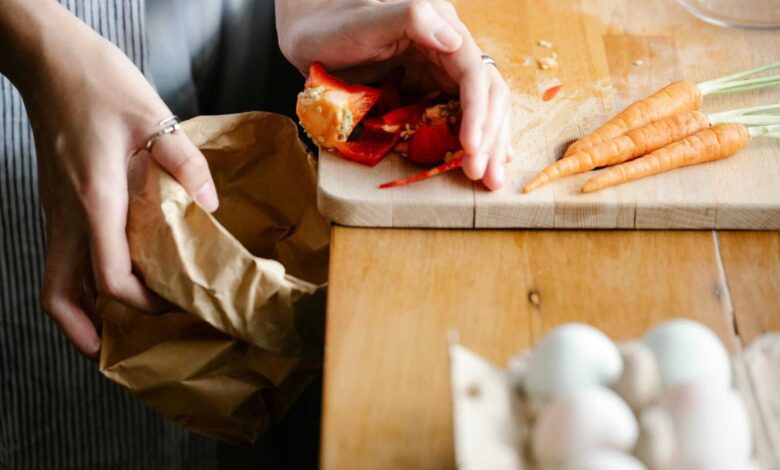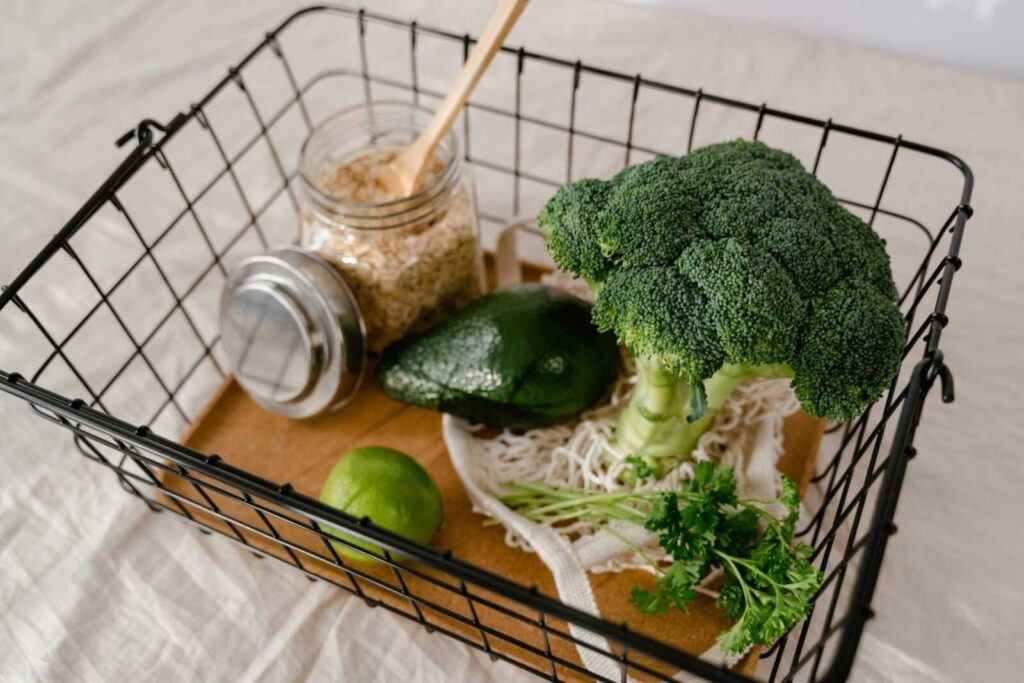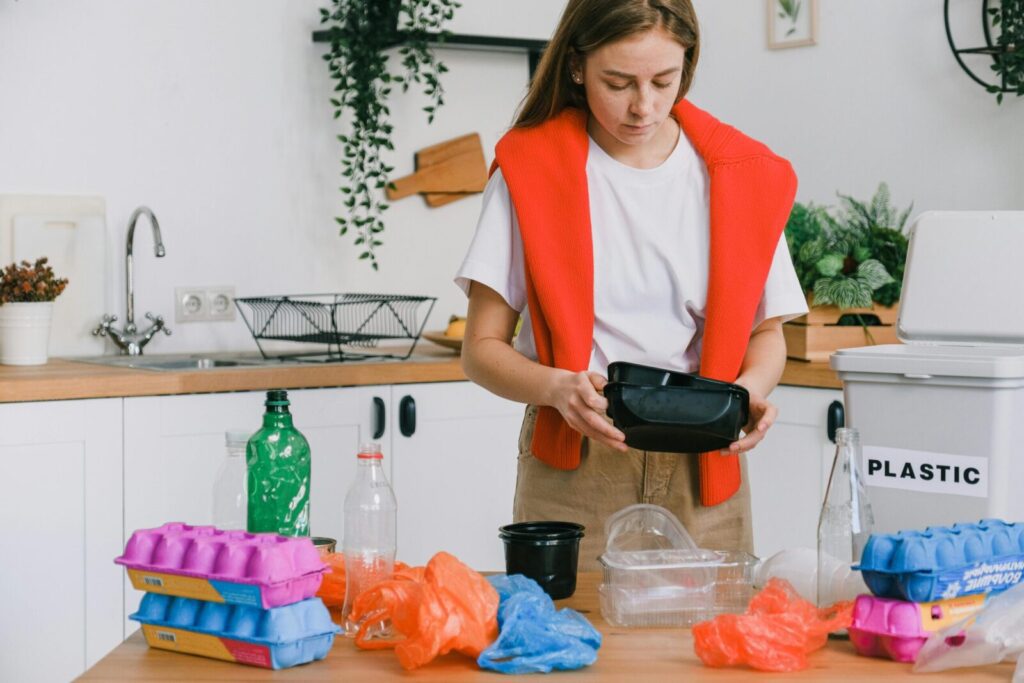Waste Not, Want Not: Tips for Reducing Food Waste in Your Kitchen

We’ve all been there: staring forlornly at a fridge overflowing with forgotten vegetables and wilting greens. Food waste is a global issue, but it doesn’t have to be a daily struggle in your kitchen. Welcome to “Waste Not, Want Not,” your ultimate guide to conquering food waste and transforming your culinary space into a haven of resourcefulness!
In this guide, we’ll unveil the secrets to becoming a champion of mindful consumption. Whether you’re a seasoned chef or a kitchen novice, we’ll equip you with practical strategies to make the most of every ingredient. Get ready to discover the magic of repurposing leftovers, the art of planning meals that prevent waste, and clever storage solutions that keep your groceries fresh for longer.
But “Waste Not, Want Not” is more than just saving money on groceries (although that’s definitely a perk!). By reducing food waste, you’re contributing to a more sustainable future. Each forgotten vegetable or wilted herb that gets a second chance is a victory for the planet.
So, join us on this exciting adventure! Prepare to be amazed at your newfound culinary creativity and discover the immense satisfaction of conquering food waste in your kitchen. Let’s turn those neglected leftovers into delectable dishes and transform your kitchen into a space of mindful abundance!
Reducing food waste in the kitchen is an essential practice that carries profound environmental, economic, and ethical implications. The growing concern over food waste is not unwarranted; it is estimated that approximately one-third of all food produced globally is lost or wasted. This staggering figure emphasizes the need for individuals, families, and communities to adopt sustainable practices to minimize food waste.
From an environmental perspective, food waste contributes significantly to greenhouse gas emissions. When food decomposes in landfills, it releases methane, a potent greenhouse gas that exacerbates climate change. By adopting strategies to reduce food waste, we can lower our carbon footprint and contribute to a healthier planet. Additionally, minimizing food waste conserves valuable resources such as water, energy, and labor that go into producing, transporting, and storing food.
Economically, food waste represents a considerable financial loss. Households can save substantial amounts of money by implementing effective food waste tips, such as meal planning for beginners and smart food storage solutions. By being mindful of how to use leftover food, families can reduce their grocery bills and make the most of their food purchases.
On an ethical level, reducing food waste addresses issues of food insecurity and social responsibility. With millions of people facing hunger worldwide, repurposing leftover food and using up pantry staples can play a small but significant role in mitigating this crisis. Understanding expiration dates and practicing food waste composting are additional steps that can help ensure that surplus food is utilized responsibly.
This blog post will provide readers with practical advice on preventing food waste, including creative leftover recipes, the best way to store leftovers, and meal prep for busy families. By the end of this guide, you will have a comprehensive understanding of how to reduce food waste in your kitchen and contribute to a more sustainable and equitable world.
Strategies for Minimizing Food Waste
Minimizing food waste in the kitchen begins with effective meal planning. By carefully planning your meals for the week, you can ensure that you buy only what you need, thus preventing excess food from going to waste. Begin by making a shopping list based on your planned meals and stick to it when you shop. This approach not only reduces food waste but also helps in managing your grocery budget more efficiently.
Portion control is another critical aspect. Cooking the right amount of food can significantly reduce the chances of leftovers that may eventually be discarded. Use measuring tools and follow recipe guidelines to ensure that you prepare suitable portions for your household. If you do end up with leftovers, there are many creative leftover recipes that can help you repurpose them into new and exciting dishes.
Understanding food expiration dates is essential for managing a zero food waste kitchen. It is important to know the difference between “sell by,” “use by,” and “best before” dates to avoid discarding food prematurely. Many foods are still safe to consume even after these dates, provided they have been stored correctly. Investing in smart food storage solutions can prolong the life of your groceries. For instance, airtight containers and vacuum-sealed bags can keep produce fresh for longer periods.
Making use of leftovers is another effective strategy. Simple practices such as freezing excess portions for later use, or incorporating leftover vegetables into soups, stews, and casseroles can prevent food waste. Additionally, using up pantry staples by incorporating them into your meal planning can help in reducing the need to buy new ingredients frequently.
Incorporating these tips into your daily routine can make a significant difference in your efforts to reduce food waste. By practicing proper meal planning, portion control, understanding expiration dates, and creatively repurposing leftover food, you can contribute to a more sustainable and efficient kitchen environment.
Reducing food waste in a small kitchen requires a strategic approach that emphasizes organization and smart utilization of available space. Limited kitchen areas often pose challenges, but with careful planning and innovative storage solutions, you can significantly minimize waste.

Organization is Key
A well-organized kitchen is crucial to reducing food waste. Start by decluttering your kitchen to create a more efficient workspace. Store frequently used items within easy reach and group similar items together. Consider using clear containers for pantry staples, which allow you to quickly see what you have on hand, preventing overbuying and ensuring you use up pantry staples before they expire.
Innovative Storage Solutions
Maximizing storage in a small kitchen is essential. Invest in stackable containers to save space in your refrigerator and pantry. Utilize shelf risers and under-shelf baskets to make the most of vertical space. A lazy Susan can be a great addition to cabinets, making it easier to access items at the back. Proper storage is one of the best ways to prolong the shelf life of your food, thereby reducing food waste. Understanding expiration dates and rotating your stock ensures older items are used before newer ones.
Maximizing Small Appliances and Utensils
Small kitchens may limit the appliances you can use, but choosing multifunctional gadgets can help you make the most of your space. A blender that also functions as a food processor, or an Instant Pot that serves multiple cooking purposes, can be invaluable. Meal prep for busy families can be streamlined by using these versatile tools, allowing you to prepare and store meals efficiently. Additionally, small-scale utensils and nesting bowls can save space without sacrificing functionality.
By implementing these strategies, you can effectively reduce food waste in your small kitchen. Remember, organization, innovative storage, and multifunctional tools are your allies in creating a more sustainable and efficient kitchen environment.
Creative Leftover Vegetable Ideas
Reducing food waste in your kitchen can be as simple as repurposing leftover vegetables into new and exciting dishes. Vegetables are incredibly versatile, and with a bit of creativity, you can transform them into delicious meals that prevent food waste. One effective method is to incorporate leftover vegetables into soups and stews. For instance, adding a mix of carrots, celery, and potatoes to a homemade vegetable soup not only enhances the flavor but also ensures that these ingredients do not go to waste.
Stir-fries are another excellent way to use leftover vegetables. By combining a variety of veggies like bell peppers, broccoli, and snap peas with a protein of your choice, you can create a quick and nutritious meal. Simply sauté the vegetables in a hot pan with some oil, add your favorite stir-fry sauce, and serve over rice or noodles. This method is particularly useful for meal prep for busy families, as it allows you to prepare several servings at once.
Casseroles offer another creative approach to repurposing vegetables. For example, a vegetable lasagna made with layers of zucchini, eggplant, and spinach can be a hearty and satisfying dish. Alternatively, consider making a quiche or frittata, where you can mix various leftover vegetables with eggs and cheese for a savory breakfast or brunch option.
For those looking to extend the life of their vegetables, smart food storage solutions are crucial. Storing vegetables properly can prevent spoilage and waste. For example, leafy greens should be stored in a crisper drawer with a slightly damp paper towel to maintain their freshness. Understanding expiration dates also plays a significant role in reducing food waste. Often, vegetables are still safe to eat past their expiration date, provided they show no signs of spoilage.
By embracing these creative and practical ideas, you can effectively use leftover vegetables, reduce food waste, and enjoy a variety of delicious meals. Whether you’re making soups, stir-fries, casseroles, or practicing smart storage solutions, the key is to remain resourceful and inventive in the kitchen.
Repurposing Leftover Fruit
Repurposing leftover fruit is a practical and creative strategy to reduce food waste in the kitchen. By identifying ripe fruit and employing proper storage techniques, you can maximize the longevity and versatility of your produce. Ripe fruit can be easily incorporated into a variety of dishes, ensuring nothing goes to waste.
Smoothies are an excellent way to use leftover fruit. Combine overripe bananas, berries, or even mangoes with a splash of yogurt or milk for a nutritious breakfast or snack. Adding a handful of spinach or a scoop of protein powder can enhance the nutritional value. Fruit smoothies are not only delicious but also a simple method to prevent food waste.
Fruit salads offer another appetizing solution. Mix together chunks of apples, oranges, grapes, and any other fruits you have on hand. A squeeze of lemon juice can help preserve the freshness and add a zesty flavor. Sprinkle with nuts or seeds for added texture and nutrition. This refreshing dish can be served as a side or a light dessert.
Baking with leftover fruit can yield delightful results. Overripe bananas are perfect for banana bread or muffins. Apples can be transformed into pies or crisps, while berries can be baked into tarts or scones. These baked goods not only satisfy your sweet tooth but also make efficient use of fruit that might otherwise go to waste.
For longer-term preservation, consider making preserves or jams. Simmer fruit with sugar and a bit of lemon juice until it thickens, then store in sterilized jars. This process extends the shelf life of your fruit and provides a homemade spread for toast, pastries, and more.
Storing fruit correctly is crucial. Keep bananas, apples, and pears at room temperature until ripe, then refrigerate to extend their life. Berries should be stored in the fridge, ideally in a single layer, to prevent mold growth. Understanding these smart food storage solutions can significantly reduce food waste.
By using up pantry staples and creatively repurposing leftover fruit, you not only prevent waste but also enjoy a variety of delicious and nutritious meals. Implementing these food waste tips ensures that every piece of fruit is utilized to its fullest potential.

How to Freeze Food to Prevent Waste
Freezing food is a highly effective strategy to extend the shelf life of various perishable items, thereby significantly reducing food waste. By understanding what foods can be frozen and how to properly prepare, store, and thaw them, you can make the most out of your groceries and prevent unnecessary disposal of edible items.
Many types of food can be successfully frozen, including meats, vegetables, fruits, dairy products, and even certain prepared meals. For instance, meat and poultry can be frozen raw or cooked, while vegetables and fruits often require blanching—a quick boil followed by an ice bath—to preserve their texture and color. Dairy products like cheese and butter freeze well, though milk may separate and is best used in cooking after thawing.
Proper preparation is crucial for maintaining food quality during freezing. Begin by portioning items into sizes suitable for your future needs. Use airtight containers or heavy-duty freezer bags to prevent freezer burn and label each package with the date of freezing to keep track of storage times. Foods with high water content, such as lettuce or cucumbers, do not freeze well due to texture changes upon thawing, so it’s advisable to avoid freezing these items.
Thawing frozen foods should be done with care to ensure safety and quality. The safest method is to thaw food in the refrigerator, which keeps it at a safe temperature during the process. For quicker thawing, foods can be placed in a sealed bag and submerged in cold water, or defrosted in the microwave using the appropriate settings. Once thawed, it’s important to use the food promptly and avoid refreezing, as this can degrade the quality and safety of the product.
By incorporating freezing into your meal planning for beginners, you can effectively reduce food waste. This method not only helps in preserving the nutritional value of your food but also allows you to repurpose leftover food creatively. Whether you’re preparing for a busy week or simply trying to minimize waste, mastering the art of freezing can be a game-changer in your kitchen.
Creative Ways to Use Stale Bread
Stale bread often ends up in the trash, contributing significantly to food waste. However, there are numerous innovative ways to repurpose leftover bread, transforming it into delicious dishes that can bring new life to your meals. Here are some versatile options to help reduce food waste in your kitchen.
Breadcrumbs
Breadcrumbs are a versatile pantry staple that can be used in various recipes, from coatings for meats and vegetables to toppings for casseroles. To make breadcrumbs, simply tear the stale bread into small pieces and spread them on a baking sheet. Bake at 300°F (150°C) for about 10-15 minutes until the bread is dry and crispy. Once cooled, pulse the pieces in a food processor until they reach the desired consistency. Store your homemade breadcrumbs in an airtight container for up to a month.
Croutons
Croutons add a delightful crunch to salads and soups. To make croutons, cut stale bread into cubes and toss with olive oil, salt, and your favorite herbs. Spread the cubes on a baking sheet and bake at 375°F (190°C) for 10-15 minutes, or until golden brown. Let them cool before storing in an airtight container. These croutons can last up to two weeks.
Bread Pudding
Bread pudding is a comforting dessert that utilizes leftover bread. To prepare, preheat your oven to 350°F (175°C). Tear the stale bread into bite-sized pieces and place them in a greased baking dish. In a bowl, whisk together 4 cups of milk, 4 beaten eggs, 1 cup of sugar, 1 teaspoon of vanilla extract, and a pinch of cinnamon. Pour the mixture over the bread, ensuring it’s well-soaked. Bake for 45-50 minutes until the top is golden and the pudding is set. Serve warm with a drizzle of caramel or a scoop of ice cream.
French Toast
French toast is an excellent breakfast option that can help you use up stale bread quickly. To make it, whisk together 2 large eggs, 1 cup of milk, 1 teaspoon of vanilla extract, and a pinch of cinnamon. Heat a skillet over medium heat and add a bit of butter. Dip each slice of stale bread into the egg mixture, ensuring it’s fully coated, and then cook on the skillet until each side is golden brown. Serve with your favorite toppings such as syrup, fresh fruit, or powdered sugar.
By employing these creative methods, you can significantly reduce food waste in your kitchen and enjoy a variety of delicious meals. Embracing these food waste tips not only helps the environment but also enhances your culinary repertoire.
Planning Meals Around Sale Items
Planning meals around sale items and discounts is a strategic approach to both saving money and reducing food waste. By focusing on supermarket sales, you can create a flexible meal plan that aligns with your budget and minimizes the risk of food spoilage. Start by reviewing weekly flyers and online promotions from your preferred grocery stores. Identify the items on sale and consider how they can be incorporated into your meals for the week.
Seasonal produce often features prominently in sales, as it is more abundant and affordable. Incorporating these items into your meal plan not only supports local agriculture but also ensures you are consuming fresh and nutritious foods. For instance, if apples are on sale, you can plan for dishes like apple pies, salads with apple slices, or even savory apple-based sauces to accompany your main courses. Similarly, if a particular meat or fish is discounted, you can center your meals around those proteins, ensuring they are used before their expiration dates.
Flexibility is key in meal planning around sale items. Instead of rigidly adhering to a specific menu, allow for adjustments based on what is available and affordable. This adaptability helps in utilizing ingredients you already have at home, thereby reducing food waste. For example, if you find a great deal on bell peppers, think of various ways to use them, such as in stir-fries, fajitas, or stuffed peppers. This way, you maximize the usage of each ingredient and avoid unnecessary purchases.
Effective meal planning also involves understanding expiration dates and smart food storage solutions. Properly storing sale items can extend their shelf life, allowing you more time to use them. For instance, freezing meat or blanching and freezing vegetables can be excellent ways to preserve them for future meals. Additionally, using up pantry staples and repurposing leftovers creatively can further minimize waste. For example, transforming leftover roast chicken into a hearty soup or using vegetable scraps for homemade stock are practical ways to ensure nothing goes to waste.
By incorporating these strategies into your meal planning routine, you can make the most of supermarket sales, reduce food waste, and enjoy a variety of meals without overspending. This approach not only benefits your wallet but also contributes to a more sustainable and environmentally friendly kitchen.
Food Waste Reduction for Restaurants
Food waste is a significant challenge for the restaurant industry, but there are several strategies that can effectively reduce it. One of the most impactful methods is implementing portion control. By assessing the average consumption patterns of customers, restaurants can adjust their serving sizes to better align with actual demand. This reduces the volume of uneaten food that ends up being discarded.
Menu design also plays a crucial role in minimizing food waste. Crafting a menu that utilizes ingredients across multiple dishes can ensure that perishable items are used efficiently. Additionally, offering a seasonal menu allows restaurants to capitalize on fresh, local produce, which not only reduces waste but also supports sustainability.
Staff training is another vital component in the effort to prevent food waste. Educating employees on proper food handling, storage, and preparation techniques can significantly cut down on spoilage and waste. For example, training staff to understand expiration dates and implement smart food storage solutions can extend the shelf life of ingredients.
Several restaurants have already taken notable steps towards reducing food waste. For instance, a renowned bistro in Paris, “Le Zero Dechet,” has adopted a zero food waste policy. They repurpose leftover food into creative leftover recipes, and any unavoidable waste is composted. Similarly, a popular New York restaurant, “Green Table,” focuses on using up pantry staples and leftovers in their daily specials, ensuring minimal waste.
These examples demonstrate that with strategic planning and a commitment to sustainability, restaurants can significantly reduce their food waste. By embracing techniques like portion control, thoughtful menu design, and comprehensive staff training, the industry can move toward a more sustainable future.
Composting Kitchen Scraps for Beginners
Composting is an effective and environmentally friendly method to reduce food waste. By converting organic kitchen scraps into nutrient-rich compost, you can significantly cut down on the amount of waste that ends up in landfills, while also enriching your garden soil. For beginners, understanding the basics of composting can help you get started efficiently and maintain a healthy compost system.
The benefits of composting are manifold. Not only does it contribute to zero food waste, but it also boosts soil health by adding essential nutrients, improving soil structure, and aiding moisture retention. Composting also reduces greenhouse gas emissions from landfills, making it a sustainable option for waste management.
To start composting, you’ll need to identify which items can be composted. Most kitchen scraps such as fruit and vegetable peelings, coffee grounds, eggshells, and tea bags are excellent additions. However, avoid composting meat, dairy products, and oily foods as they can attract pests and create unpleasant odors. Yard waste like grass clippings and leaves can also be included, making it easier to manage garden waste effectively.
Setting up a compost bin at home is straightforward. You can use a simple outdoor compost bin, a compost tumbler, or even a small indoor composting system if space is limited. Start by layering green materials (like kitchen scraps and fresh grass clippings) with brown materials (such as dried leaves, cardboard, and newspaper). This balance ensures proper decomposition and minimizes odors.
Maintaining a healthy compost system requires regular attention. Turn the compost pile every few weeks to aerate it, which helps speed up the decomposition process. Keep the compost moist but not waterlogged; it should feel like a damp sponge. Monitoring the temperature can also be beneficial; an active compost pile will generate heat, indicating that microorganisms are breaking down the material effectively.
By incorporating these food waste tips into your daily routine, you can make a positive impact on the environment. Composting not only reduces food waste but also offers a practical way to repurpose leftover food and other organic materials, contributing to a more sustainable lifestyle.
How to Use Leftover Food
Repurposing leftover food is an effective strategy to reduce food waste while also saving time and money. One of the best ways to use leftover food is to transform it into new, delicious meals. For instance, leftover roasted vegetables can be blended into a hearty soup or mixed into a frittata for a nutritious breakfast. Similarly, cooked grains like rice or quinoa can be revitalized by creating a stir-fry or a grain bowl with fresh toppings.
Another creative approach is to incorporate leftovers into recipes that mask their original form, making them feel like entirely new dishes. Leftover chicken, for example, can be shredded and used in tacos, enchiladas, or even a chicken salad. If you have extra pasta, consider baking it into a cheesy casserole or adding it to a soup for added substance.
Practical tips for repurposing leftover food include planning meals that can easily incorporate leftovers. For example, if you roast a large chicken, plan to use the leftover meat in sandwiches, salads, or soups throughout the week. Meal planning for beginners should always include strategies for using up leftovers to ensure nothing goes to waste.
Additionally, understanding expiration dates and smart food storage solutions can significantly help in managing and utilizing leftovers. Properly storing leftovers in airtight containers and labeling them with dates ensures they remain safe to eat and easily accessible. Moreover, using up pantry staples in conjunction with leftovers can result in creative and satisfying meals. For instance, canned beans, spices, and broths can complement leftover meats and vegetables to create a flavorful stew or chili.
Finally, exploring creative leftover recipes can be both enjoyable and practical. Websites and cookbooks dedicated to zero food waste offer numerous ideas to repurpose food effectively. By embracing these strategies, you can not only prevent food waste but also enjoy a variety of meals crafted from ingredients you might otherwise discard.
Food Waste Tips
Reducing food waste in the kitchen is not only environmentally beneficial but also economically advantageous. Implementing effective food waste tips can significantly minimize the amount of food discarded. One of the most impactful practices is meal planning for beginners. By planning meals ahead of time, you can purchase only what you need, thereby reducing the likelihood of excess food going to waste. A well-thought-out meal plan includes a shopping list tailored to specific recipes, which helps in avoiding impulse buys and ensures that all ingredients are used efficiently.
Smart food storage solutions are another crucial aspect of reducing food waste. Understanding expiration dates and how to store different types of food can prolong their shelf life. For instance, perishable items like fruits and vegetables should be stored in designated compartments in the refrigerator to maintain their freshness. Investing in airtight containers can also help in preserving the quality of food for longer periods, making it easier to use leftovers creatively.
Speaking of leftovers, repurposing leftover food is an excellent way to prevent waste. There are numerous creative leftover recipes that can transform yesterday’s dinner into today’s lunch or a new dish entirely. For example, leftover roasted vegetables can be turned into a hearty soup, while stale bread can be repurposed into croutons or bread pudding. The best way to store leftovers is in clear containers so you can easily see what you have and remember to use them before they spoil.
Additionally, using up pantry staples is a practical method to ensure that older items are consumed before purchasing new ones. Regularly checking your pantry and rotating items so that older products are at the front can help in reducing food waste. Finally, food waste composting is a sustainable practice for any food scraps that cannot be repurposed. Composting not only reduces the amount of waste sent to landfills but also enriches the soil for future gardening.
By adopting these food waste tips, you can make a positive impact on both the environment and your wallet. Simple changes in meal planning, food storage, and utilizing leftovers can lead to a more sustainable kitchen and a significant reduction in food waste.
Best Way to Store Leftovers
Proper storage of leftovers is crucial to reducing food waste and ensuring that your meals remain fresh and safe to eat. The best way to store leftovers begins with selecting the right containers. Opt for airtight containers made of glass or BPA-free plastic, as they help preserve the quality of the food and prevent contamination. Additionally, using containers of various sizes can help in storing different portions efficiently, minimizing the space occupied in your refrigerator or freezer.
Labeling is another essential step in effective leftover storage. Clearly mark each container with the contents and the date it was prepared. This practice not only helps in keeping track of what needs to be consumed first but also prevents the mystery of unidentified foods lurking in the back of the fridge. For optimal food safety, consume refrigerated leftovers within 3-4 days and frozen leftovers within 2-3 months.
When it comes to reheating leftovers, the key is to do it without compromising the quality of the food. For most foods, reheating on the stovetop or in the oven yields better results than using a microwave, as it helps maintain texture and flavor. Microwaves can cause uneven heating, leading to potential food safety issues and a less appetizing meal. If you must use a microwave, stir the food halfway through the heating process to ensure even warming. Adding a splash of water before reheating can also help retain moisture, especially for dishes like pasta or rice.
Incorporating these smart food storage solutions can significantly reduce food waste in your kitchen. By understanding expiration dates and employing proper storage techniques, you can make the most of your leftovers, ensuring they remain a safe and delicious part of your meals. Not only does this practice contribute to zero food waste, but it also promotes better meal planning and resourcefulness in your culinary endeavors.
Congratulations! You’ve taken a giant leap towards a more sustainable kitchen and a more resourceful approach to food. By embracing the tips and strategies outlined in this guide, you’ve become an active participant in reducing food waste and its environmental impact.
Remember, even small changes can have a massive ripple effect. By planning your meals, mastering the art of leftovers, and utilizing smart storage solutions, you’re not only saving money but also contributing to a more sustainable future.
So, the next time you glance into your fridge, don’t despair! See it as a canvas for culinary creativity. Transform wilting greens into a vibrant pesto, repurpose leftover chicken into a heartwarming soup, and discover the joy of utilizing every last bit of your ingredients.
Let your kitchen be a testament to the power of resourcefulness. Share your newfound skills with friends and family, and inspire them to join the movement towards a waste-free kitchen revolution. Together, we can make a delicious difference, one bite at a time!

Waste Not, Want Not: FAQ
This FAQ tackles common questions about reducing food waste in your kitchen, empowering you to become a champion of mindful consumption.
1. I always seem to overbuy groceries. How can I plan my meals better?
Meal planning is key! Start by taking inventory of what you already have in your pantry, fridge, and freezer. Then, plan meals around those ingredients to avoid unnecessary purchases. Many online tools and apps can help you create meal plans and grocery lists.
2. What’s the best way to store leftovers to prevent spoilage?
Store leftovers in airtight containers within two hours of cooking. Cool them quickly in shallow containers rather than deep pots. Label containers with the date to avoid lingering mysteries in the fridge.
3. Help! My vegetables are starting to wilt. Is there anything I can do?
Don’t despair! Wilted vegetables can often be revived with a cold water bath. Simply submerge them in cold water for 10-15 minutes and watch them perk up! Wilted greens can also be used in smoothies or soups.
4. I’m not sure what to do with leftover bits and bobs of ingredients. Any suggestions?
Embrace creativity! Leftover vegetables can be transformed into delicious frittatas, stir-fries, or soups. Stale bread can be used for croutons, bread pudding, or breadcrumbs. Get creative and explore online resources for recipe inspiration.
5. Is it safe to freeze leftovers?
Absolutely! Freezing is a fantastic way to extend the shelf life of leftovers. Invest in freezer-safe containers and portion leftovers into individual servings for convenience. Just be sure to label them with the date!
6. What about fruits that are past their prime? Are they a lost cause?
Not necessarily! Soft fruits are perfect for smoothies, jams, or baking into muffins or breads. Even bruised bananas can be frozen for banana bread later.
7. I’m composting curious! How can I get started?
Composting is a great way to turn food scraps into nutrient-rich fertilizer for your plants. There are many countertop composting bins available for small spaces, or you can explore backyard composting options.
8. What are some smart storage solutions to keep my food fresh longer?
- Proper container use: Invest in airtight containers for pantry staples and leftovers.
- Organize your fridge: Store fruits and vegetables in the crisper drawers, and keep raw meat on the bottom shelf to prevent cross-contamination.
- First-in, first-out: Rotate your groceries, using older items first to prevent them from expiring in the back of the fridge or pantry.
9. Are there any apps that can help me reduce food waste?
Yes, there are several apps available that can help you plan meals, create grocery lists, and track your food inventory to prevent overbuying.
10. Small changes, big impact? How can I get started?
Start small! Focus on one or two changes at a time, like planning your meals for the week or utilizing reusable grocery bags. Every step towards reducing food waste makes a difference!




